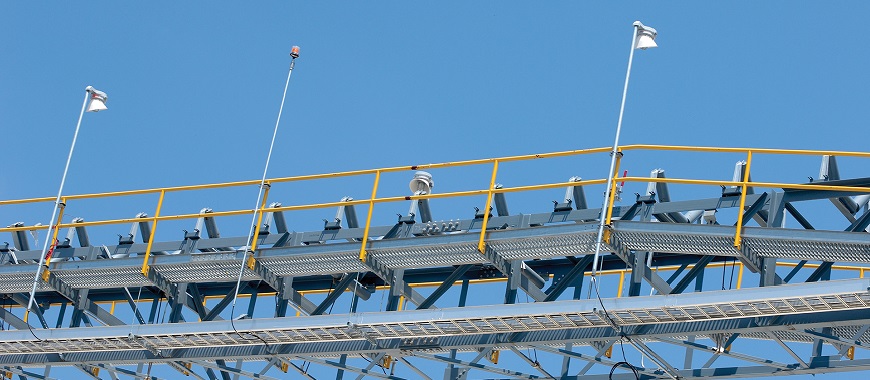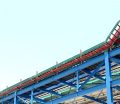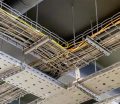
Effective cable management is crucial for modern infrastructure, ensuring organized and efficient wiring systems. With increasing complexity in electrical setups, the demand for reliable solutions has grown significantly. A curved cable tray is an innovative option designed to meet these challenges.This type of tray enhances wiring efficiency by allowing smooth transitions around bends and corners. Unlike traditional cable trays, a curved cable tray minimizes cable stress and prevents unnecessary wear during installation. It is particularly useful in industrial and commercial environments where precision and durability are essential.By supporting cables in curved pathways, a curved cable tray helps maintain system integrity and simplifies maintenance. This solution promotes better organization and improves the overall functionality of electrical systems.
What Is a Curved Cable Tray?
A curved cable tray is a fundamental component for managing cables in both industrial and commercial setups. It enables streamlined cable routing by offering structural support for wiring, particularly in situations where bends and curves are required. Designed to reduce stress on cables and ensure organized layouts, this tray system has become essential in modern infrastructure.
Curved cable trays are vital for accommodating complex layouts. They help maintain the integrity of the wiring system, providing an effective solution for managing cables in environments with tight corners or irregular pathways. These trays are often made from materials such as aluminum, steel, or fiberglass, each suited for specific applications. At GangLong Fiberglass, we provide solutions that prioritize both functionality and durability.
The Types of Cable Trays
Cable trays are categorized into different types, each tailored for specific wiring needs. Among these, ladder trays, solid bottom trays, and enclosed trays play significant roles in curved cable tray systems.
Ladder Cable Tray
Ladder cable trays are one of the most commonly used types in cable management systems. They consist of two side rails connected by cross members, forming a ladder-like structure.
Features and Applications of Ladder Cable Trays
Ladder cable trays are known for their open structure, which allows excellent ventilation for cables. This design is particularly effective in industrial setups where heat dissipation is critical. They are also lightweight yet sturdy, making them suitable for curved cable tray installations in larger facilities.
Benefits of Using Ladder Trays in Curved Installations
In curved cable tray configurations, ladder trays offer flexibility. Their modular design enables them to adapt to bends without compromising the structural integrity of the wiring system. This adaptability makes them ideal for projects requiring both straight sections and curves.
Solid Bottom Cable Tray
Solid bottom cable trays provide a secure solution for wiring that requires additional protection. Unlike open designs, these trays have a completely covered base.
Overview of Solid Bottom Cable Trays for Secure Wiring
Solid bottom trays are highly effective in environments where cables need protection from dust, moisture, or mechanical damage. They are commonly used in indoor settings and for sensitive data cables that require shielding. When integrated with a curved cable tray system, these trays maintain security even in complex layouts.
Enclosed Cable Tray
Enclosed cable trays, also known as channel trays, are designed to fully encase cables, offering maximum protection.
When to Use Enclosed Cable Trays in Complex Setups
These trays are suitable for setups where environmental factors, such as exposure to chemicals or extreme temperatures, pose a risk to wiring. They are particularly useful in areas with high levels of contamination or for wiring systems that require complete isolation.
Advantages of Enclosed Systems for Dust and Damage Protection
The fully enclosed design ensures that cables are shielded from external damage. This feature is essential for maintaining system reliability in challenging industrial or outdoor conditions. When used as part of a curved cable tray system, these trays enhance the overall durability and longevity of the installation.
Curved Cable Tray Sizes and Specifications
Choosing the right curved cable tray size is essential for optimizing performance and ensuring seamless integration into your project. Understanding the available sizes and specifications is key to achieving the best results.
Typical Sizes and Dimensions Available for Curved Cable Trays
Curved cable trays are available in various widths, depths, and radii. Common sizes include widths ranging from 6 inches to 36 inches and depths of 4 inches to 8 inches. At GangLong Fiberglass, we offer custom sizing options to suit specific project needs.
How to Choose the Right Size for Your Project
The size of the curved cable tray should be determined by the number and type of cables it will support. Factors such as cable diameter, weight, and required spacing should be considered. Accurate measurements ensure that the tray can accommodate current needs while leaving room for future expansion.
Adjustability and Compatibility with Industrial Cable Trays
Many curved cable trays are designed to be modular, allowing for easy adjustments during installation. Compatibility with industrial cable tray systems ensures that they can be integrated with existing setups or other types of trays, such as ladder or solid bottom trays.
Why Choose Epoxy Cable Tray for Industrial Use
Benefits of Curved Cable Trays
The curved cable tray offers multiple advantages, making it a preferred choice for complex wiring systems. Its benefits span across various aspects of cable management and infrastructure maintenance.
Smooth Wiring Transitions for Complex Layouts
Curved cable trays facilitate seamless cable routing in spaces with corners, bends, or irregular pathways. This smooth transition prevents cable kinks and ensures an organized appearance.
Reduced Stress on Cables During Installation
By providing adequate support in curved sections, these trays minimize stress on cables. This feature reduces the risk of damage during installation and extends the lifespan of the wiring system.
Durability and Adaptability in Industrial Environments
Curved cable trays are constructed from robust materials, ensuring their durability in harsh conditions. They are resistant to corrosion, temperature fluctuations, and mechanical impacts, making them suitable for industrial applications.
Efficient Space Utilization
The ability to fit into curved spaces allows these trays to optimize the use of available space. They can be installed in tight areas, ensuring maximum efficiency in cable management.
Simplified Maintenance and Upgrades
Curved cable trays offer easy access to cables, making maintenance and future upgrades more manageable. Their open design allows technicians to identify and address issues quickly without disrupting the entire system.
This comprehensive guide outlines the importance, types, sizes, and benefits of curved cable trays, emphasizing their critical role in modern wiring systems. Whether you need a solution for smooth cable transitions or a robust system for challenging layouts, curved cable trays and cable tray curve designs offer unmatched functionality and reliability. At GangLong Fiberglass, we provide solutions tailored to meet the diverse needs of industrial and commercial environments. For further inquiries, explore our offerings and find the perfect curved cable tray or cable tray curve for your project.
Benefits of Using Concrete Cable Tray Systems
How to Install Curved Cable Trays
Installing a curved cable tray requires careful planning and execution to ensure optimal performance. Proper installation enhances the reliability and durability of your wiring system, making the tray a vital component in managing cables efficiently.
Step-by-Step Guide to Setting Up Curved Cable Trays
- The first step in installing a curved cable tray is assessing the layout of the area. Measure the available space and identify where the curves will be positioned. Once the layout is mapped, choose the appropriate size and type of curved cable tray, such as those offered by GangLong Fiberglass, which are designed for seamless installation.
- Prepare the site by clearing any obstructions and ensuring that the surface is level. Mark the locations where the tray will be anchored, ensuring alignment with other components. Assemble the tray sections on the ground, connecting them to create the desired curve before mounting them on the supports.
- Install the supports at the marked locations, ensuring they are secure and stable. Attach the curved cable tray to the supports, checking for proper alignment at each stage. Tighten all fasteners and confirm the stability of the structure.
- Route the cables through the tray, following the curves carefully to prevent tangling or damage. Use cable ties to secure the wiring and maintain an organized system.
Tools and Hardware Required for Secure Installations
A successful curved cable tray installation requires specific tools and hardware. Commonly used tools include measuring tapes, drills, wrenches, and pliers. For safety, wear protective gear such as gloves and goggles during the installation process.
The hardware for installation typically includes brackets, clamps, and fasteners. GangLong Fiberglass offers curved cable tray kits with pre-included mounting hardware, making the setup process more efficient. Ensure all tools and materials are readily available before starting the project.
Tips for Aligning Curved Cable Tray Corners
Aligning the corners of a curved cable tray is a critical step to achieve a smooth and functional installation. Begin by ensuring that the tray sections are aligned at the correct angles before fastening them together. Use alignment tools, such as spirit levels, to confirm precision.
To maintain structural integrity, avoid forcing the tray into unnatural bends. Instead, use pre-curved sections that match the layout. For tighter corners, consider using adjustable components from GangLong Fiberglass that are specifically designed for such situations.
Secure each corner with additional brackets to prevent movement and maintain stability. Regularly inspect the alignment as you progress to ensure the tray remains level and securely fastened.
Linear Heat Detector for Cable Tray Fire Safety Solutions
Additional Resources for Cable Tray Systems
Curved cable tray systems require consistent maintenance and access to accurate information for optimal performance. Various resources are available to assist in selecting, installing, and maintaining these systems effectively.
Guides for Working with Industrial Cable Tray Solutions
Industrial cable tray solutions often involve unique challenges due to their scale and complexity. Detailed guides can provide insights into handling these situations. For example, GangLong Fiberglass offers manuals tailored to curved cable tray installations, ensuring accurate assembly and long-term reliability.
Such guides typically cover best practices for securing trays, managing cables, and troubleshooting issues. These resources are invaluable for ensuring the successful implementation of curved cable tray systems in industrial settings.
Accessing Catalogs and PDFs for Cable Tray Specifications
Catalogs and PDFs are essential for selecting the right curved cable tray for your needs. They provide detailed information on sizes, materials, and configurations available. GangLong Fiberglass offers a comprehensive catalog featuring curved cable trays with specifications that cater to diverse applications.
Reviewing these documents can help identify the tray that matches your project’s requirements. Look for dimensions, weight capacities, and material options to make informed decisions.
Insights into Maintenance and Upgrades for Long-Term Performance
Regular maintenance is crucial for the longevity of curved cable tray systems. Inspections should be performed to check for signs of wear, misalignment, or damage. Cleaning the tray periodically prevents debris buildup and ensures smooth cable routing.
Upgrading your curved cable tray system may be necessary as your wiring needs evolve. GangLong Fiberglass provides options for modular additions and replacements, allowing for seamless upgrades without extensive modifications.
Wrapping Up the Benefits of Curved Cable Trays
Curved cable trays offer numerous advantages, making them a valuable solution for managing complex wiring systems. These trays facilitate smooth transitions around corners, ensuring organized and efficient cable layouts. By reducing stress on cables, they enhance system reliability and longevity.
Their durability in industrial and commercial environments ensures they can withstand harsh conditions, while their modular design simplifies both installation and future upgrades. Curved cable trays also improve space utilization, making them suitable for even the most challenging layouts.
Adopting modern curved cable tray solutions, such as those provided by GangLong Fiberglass, can streamline your wiring setup and improve overall performance. By investing in these advanced systems, you ensure a reliable and efficient infrastructure for years to come.
FAQs about Curved Cable Tray
The three main types of cable trays are ladder trays, solid bottom trays, and enclosed trays. Ladder cable trays have side rails with cross rungs that allow for ventilation and easy cable maintenance. Solid bottom trays have a fully covered base, offering protection for sensitive cables against dust and moisture. Enclosed trays, also known as channel trays, completely encase the cables, providing maximum protection in harsh environments. These types serve specific purposes and can be integrated into curved cable tray systems for customized wiring solutions.
Cable trays and cable trenches are both used for routing cables, but they differ significantly in design and application. A cable tray is a structural system installed above ground to support and organize cables, often including curved sections like those in curved cable trays. A cable trench, on the other hand, is an underground or surface-level channel used to house cables. Cable trays are more flexible and easier to install, while cable trenches are permanent and require more planning for construction.
The life expectancy of a cable tray depends on its material and the environment where it is installed. Metal cable trays, such as those made of steel or aluminum, can last 20 to 30 years when properly maintained. Fiberglass cable trays, like those offered by GangLong Fiberglass, are highly durable and resistant to corrosion, often exceeding 30 years in harsh conditions. Regular inspections and maintenance help extend the lifespan of cable trays.
Cable trays are often more cost-effective than conduits for managing large volumes of cables. Unlike conduits, which require individual cables to be enclosed, cable trays provide an open structure that can hold multiple cables together. This reduces installation time and labor costs. Curved cable trays, specifically, can also save money by simplifying routing around bends and corners without additional materials or adjustments. The overall cost-effectiveness of cable trays makes them a popular choice in industrial and commercial applications.

As the editor of GangLong Fiberglass, I have years of experience and in-depth research, focusing on cable tray products, fiberglass solutions, and grille systems. I incorporate years of industry insights and practical experience into every content, committed to promoting the progress of the industry. At GangLong Fiberglass, my commitment is reflected in every product, from innovative cable trays to durable fiberglass solutions and sturdy grille systems. As an authoritative voice in the industry, my goal is to provide valuable information to professionals and businesses and promote forward-looking solutions.


